This was published 4 years ago
Venice, Italy travel guide: The secret Venice tourists don't know about
By Ben Groundwater
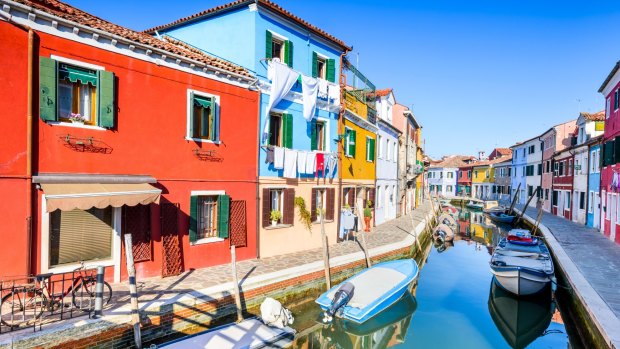
Burano is a quiet part of overcrowded Venice.Credit: Alamy
There's a distant clop of feet on stone, a beat that's growing more insistent, a sound that's bouncing off brightly-coloured walls and soaring over tiled rooftops as it gets louder, as its source nears. Here in Burano the streets are ghost-town empty this morning, it's an island at peace but for the urgent thud of those approaching steps.
The clop gets louder, and louder, and then suddenly a young man in trousers and a polo shirt, messenger bag slung over his shoulder, rounds a corner of a narrow alleyway and almost clatters into me as he sprints past, the sound of his feet on stone pavers tapering off like a passing siren as he sprints towards the port.
He's running for the vaporetto – one of the Venice area's famous waterbuses – but he's about to miss it and, presumably, find himself late for work. I was down at the dock a few minutes ago, strolling past as the only people awake at this time of morning were getting ready to board and make their way into the big city, to Venice, to their jobs.
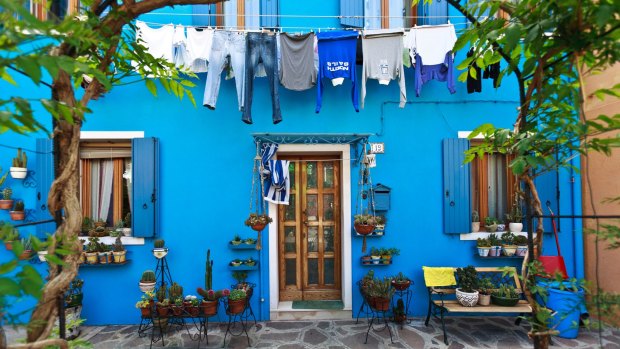
Laundry day at one of the colourful houses on Burano island.Credit: Alamy
Once that first vaporetto has cast off lines and chugged away, Burano will be quiet once again, its canals glassy, its old stone alleyways deserted, its charmingly wonky belltower silent in the pastel morning glow.
My early-morning access to this lovely little place is thanks to another, quite different boat: a live-aboard vessel that's bobbing on its moorings a few hundred metres away in a shallow canal. I arrived here yesterday under its steam; I'll depart this afternoon in the same fashion.
Burano is just part of a much wider exploration of the Venice area, a week-long self-drive cruise with the company Le Boat in the company of my partner and our nine-month-old son.
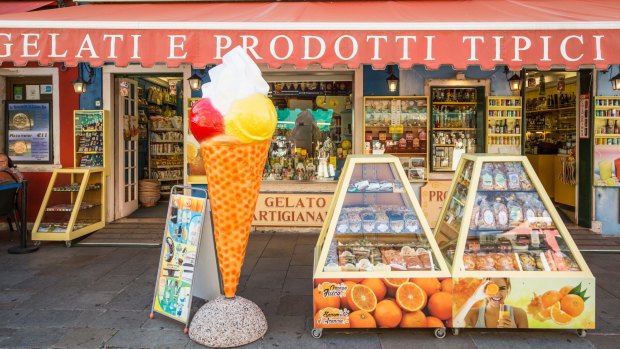
A Gelati shop in the Venetian village of Burano, Venice.Credit: Alamy
This, I've come to realise over the past six or seven days, is a sure way to cruise Venice properly. This is how to avoid being one of the tens of thousands of package tourists disgorged onto that busy island on a daily basis.
This is how to lessen your impact on a destination that's struggling to cope, how to spread your tourist dollars and your physical presence around to the smaller towns and islands that were also settled by the Venetians, that bear the same history as Venice, only without the untamed crowds.
This is how to see the waterways that connect the dots, too, how to explore the lifelines of the Venetian republic, how to view birdlife, how to chug slowly through rural idyll, how to take charge of your itinerary and your destiny and your life.
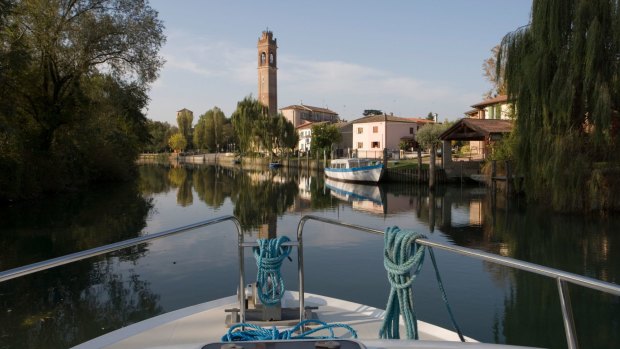
Houseboat cruise on the Sile River, Casale sul Sile, Venice.Credit: Alamy
This is how to have fun.
THE TRUE SERENISSIMA
It's 7am and I'm the only tourist on this beautiful Venetian island. It's too early for the day-trippers to arrive from Venice. It's too soon for those few who've scored a bed in a B&B here to venture outside, to grab coffee from cafes that won't open until at least 9am, to wander streets that won't come alive until much later.
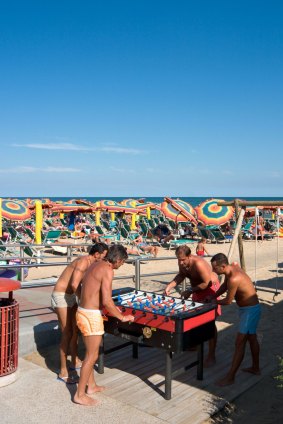
Table soccer on the beachfront promenade at Lido de Jesolo, Venetian Riviera.Credit: Alamy
Burano in the late evening and the early morning, after the last vaporetto and before the first, is a strange thing: a tourist-free Venetian paradise, a charm-soaked town where no Instagram-inspired visitors roam, an island of canals that contain no gondolas, of streets that lie silent and serene.
This lovely little island with the riotously coloured houses is, in short, everything that Venice is not. That city is so famously overcrowded, so dangerously overtouristed. Burano isn't, particularly at the extremes of the day.
This is the true "Serenissima", where local life ebbs and flows around you like the tides, as fishermen putter past in their little boats, as workers run to catch vaporetti, as nonnas gather below windows hung with laundry to catch up on the news.
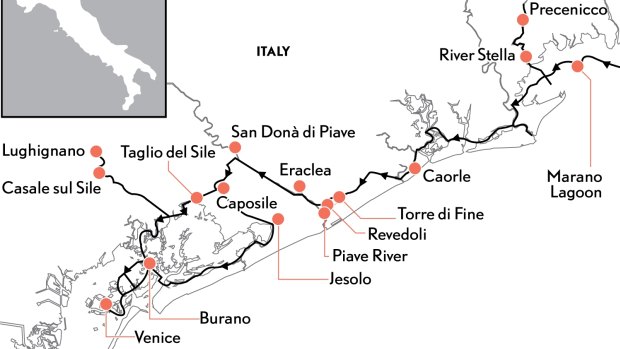
The system of canals between Precenicco and Venice.Credit: SMH Graphics
LIFE IN THE SLOW LANE
Six days earlier, however, it didn't seem like such fun. We'd arrived to begin our cruise in the town of Precenicco, a blink-and-you'll-miss-it village in the Friuli-Venezia Giulia region of north-eastern Italy. The town may seem obscure, but it provides ideal access to a network of canals, rivers and channels that eventually link up with the Venetian Lagoon some 50 kilometres south-west.
The way we'll get there is by boat: specifically, a "Minuetto 6", a live-aboard vessel with room for far more than just the three of us (though nine-month-olds do have a surprisingly large footprint). There's a kitchen, a deck with outdoor dining, an indoor eating area, three bedrooms, two bathrooms and a shower. Top speed: not much.
The reason we're not having fun, however, is the weather. It's unseasonably cold in Precenicco today, with drizzling rain, and it doesn't look like improving. Tomorrow, a large storm is blowing in. The rain will stretch on for days. My partner's sunhat and bikini are looking like sadly ironic inclusions.
No one stays in Precenicco too long. Not on a normal trip, anyway. They take their safety briefing and cast off, making their way down the River Stella towards the Marano Lagoon, a sprawling body of water on the pathway to Venice.
But we're not going anywhere today, and we won't go anywhere tomorrow. The tide is wrong this afternoon, we'll run aground in the shallow lagoon; tomorrow, we'll be buffeted by wild, wintry weather – the sort of storms houseboats have no business going out in. It will be day three before we eventually begin our adventure. Such is life when you depend on the weather.
When we do finally get going, however, it's glorious. There's a pleasure to piloting your own vessel that's hard to describe. I sit up on the open deck at the wheel, call to my partner, Jess, to let the lines go, and we're away, chugging down the Stella, watching as Precenicco disappears behind a bend in the river and farms and vineyards appear around another. The towering Dolomites that mark the beginning of Austria and Slovenia are a brilliant white smudge on the distant horizon.
This is life in the slow lane. Scenery oozes past like molasses; there's time to watch swans paddle by serenely, to see water hens picking at river debris, to wave to farmers as they raise their heads at the sound of our boat. A cup of hot tea wards off the cold. The sight of the vastness of the Marano Lagoon ahead warms the soul.
We're off.
A LITTLE TIME IN LITTLE VENICE
The first major stop is Caorle, a coastal town in the Veneto region, a place founded by Romans and developed by Venetians, one of the most important hubs for the latter republic. It takes the best part of a few days to get here, days we spend motoring from wide lagoon to narrow canal, from fast-flowing river to sluggish channel.
The sun finally shines on day four, when the riot of colour that is the Venetian landscape reveals itself. Fields of linseed are laid out in buttery yellow blankets; the scarlet splash of poppies gives the riverbanks an impressionist's flair; wildflowers appear in every hue.
There are birds, too: herons and swans, ducks and gulls, water hens and terns. Fishermen nod to us from riverbanks. Cyclists glide past, making the most of the clear day.
A low bridge just outside Caorle has to be swung open for us to pass, forcing road traffic to pause as we make our leisurely way past the fishing boats and recreational craft moored on the riverbanks, and motor into the marina to tie up for the night and explore.
Almost immediately, Caorle is strikingly reminiscent of Venice. This is a smaller, more personal version of that famous island, where the architecture is so familiar – brightly coloured old houses crowded around labyrinthine paths.
The haphazard shape of those alleys is recognisable, too, because they were once canals just like Venice, only here the decision was made to fill them in and pave them over long ago.
Still, it's not difficult to imagine that these streets are the waterways of old. Blink and Caorle's wide main boulevard becomes its Grand Canal; squint and its narrow alleyways hold gondolas and other little watercraft. It's like you're walking on water.
ARISE, THE REAL VENICE
Venice is of course an important destination for us to visit on this trip. It's an amazing city, truly beautiful, and wildly popular for a reason. Visiting places like Caorle, however, gives context to Venice. It makes you realise the island city is not a singularity, but the most spectacular piece of a much larger and more impressive whole.
Venice was an empire, not a city. Its legacy is spread far and wide. Soon it's time to discover more of that legacy. We cast off from Caorle the next morning and join the Canale Revedoli, a manmade artery that leads through a jigsaw puzzle of fields and groves, those snow-capped Dolomites still lurking on the horizon.
We pass through small Venetian towns such as Torre di Fine and Revedoli, before making a turn onto the wide Piave River and motoring upstream past Eraclea and San Dona di Piave.
These are settlements you'd never normally see – remnants of the Venetian Republic that thrive today in modern Italy. There's the odd bit of challenging boating to get through them, too, with swing bridges and narrow locks to negotiate, but I manage to guide our boat through without incident.
There's a problem still to come today though. The swing bridge at Caposile is out of action; the bridge-keeper crosses his arms in front of him to let us know from afar. Nothing happening today.
We're forced to take a detour down a meandering branch of the Sile River towards the beach resort town of Jesolo, where we'll tie up near a lock for the night, ready to finally enter the Venetian Lagoon the following morning.
ISLAND LIFE
The Venetian Lagoon covers 55,000 hectares. Plenty of space, but that doesn't mean you can take a boat wherever you like in that vast expanse.
Most of the lagoon is mud flats and tidal shallows, where water is knee deep at best - hence the canals and the network of channels that runs in a pattern like shattered glass.
We join that network early in the morning, entering the lagoon from Jesolo, watching huge flocks of flamingos feeding in the shallows next to the narrow canal as I guide our boat through. Finally, we see traffic. Up until this morning we'd been passing maybe one boat a day, going hours and hours without seeing a single vessel. In the lagoon, however, you see vaporetti, the famous ferries, as well as fishing boats and other commercial craft.
Our destination this morning is Burano, that beautiful, sleepy island in the centre of the lagoon. From there we'll take a vaporetto into Venice to explore some of its quieter corners, to step away from Piazza San Marco and the Grand Canal and to discover just how easy it is to find the "real" Venice when you don't follow the crowds.
We'll then return to Burano, to enjoy strolling its paved pedestrian streets once the sun has dipped below the horizon, when the day-trippers have all gone and the locals have reclaimed their home.
There are a few more days on the water ahead, too, as we motor up the Sile River to Casale, past spectacular old villas and waterways languidly draped with tree branches, and then on to the houseboat base in the town of Lughignano.
For now, however, Burano is ours. The streets, the bars, the restaurants, the canals. The peace. The solitude. Ours.
See also: 'Addicted to cash': Why Venice is dying
See also: Tourists abandon one of the world's worst countries for overtourism
Emirates has daily flights from the all major Australian ports to Venice, via Dubai. See emirates.com From Venice, taxis are available for the short trip to Precenicco.
CRUISE
Le Boat offers self-drive cruises in nine countries, with a fleet of 900 modern cruisers. In the Venice and Friuli regions, the company has two bases, in Casale sul Sile and Precenicco, with several itineraries possible.
Seven-night cruises start from $699 per person in a two-cabin cruiser; the Minuetto, with space for six people, is available from $3999 for seven nights. No prior boating experience or licence is required for all Le Boat holidays, and a full briefing is provided on arrival.
Le Boat offers private moorings in the Venetian lagoon for customers, from where they can explore Venice and the outlying islands. See leboat.com.au
FIVE MORE VENETIAN CITIES (THAT AREN'T VENICE)
PADUA
This medieval city is only a stone's throw from Venice, and yet it receives a mere fraction of the visitors. That's a shame, because people are missing a lively university town filled with bustling piazzas, ancient marketplaces and several cathedrals with stunning Renaissance-era frescoes.
ASOLO
Nestled in the foothills of the Dolomites, Asolo is known as the "town of 100 vistas" thanks to the spectacular views the town affords. There's plenty of interest on the ground, too, a rambling set of villas and mansions that for centuries have drawn writers and artists to call this place home.
PORTOGRUARO
There's an understated charm to Portogruaro and its twin town of Concordia Sagittaria, two small settlements on the banks of the Lemene River. Both are quiet communes with plenty of Venetian history, including a series of spectacular palaces in Portogruaro, and the Cathedral of St Stephen in Concordia.
VERONA
This famous city was once a stronghold of the Venetian Republic, a fortified trading post that became a cultural hub. Though it's best known for its Roman amphitheatre and its Shakespearian associations, there are plenty of Venice-era attractions to be found.
MURANO
The most obvious doppelganger of the city of Venice is the island next door: Murano, known worldwide for its glass-making, and a charming, worthwhile destination in its own right. Here you'll find Venetian canals, stately palaces, centuries-old churches, and, of course, glassworks.
FIVE MORE LOW-IMPACT, SMALL-SHIP CRUISES
DELPHIN AMAZON, PERU
The Delphin II is small-ship cruising at its finest, a luxury vessel with only 14 cabins, which means you'll be exploring the Peruvian Amazon with only 28 passengers sharing the experience. The small group keeps the impact low and Delfin runs numerous outreach programs that support the local riverine communities. See chimuadventures.com.au
STAR CLIPPERS, CARIBBEAN
How do you avoid burning fuel? Sails. And the three tall ships in the Star Clippers fleet have a lot of them, enough to switch the engines off entirely for 70 per cent of their time at sea. The ships also have small capacities, use water purification to turn sea water into drinking water, and have been awarded the International Air Pollution Prevention certificate. See starclippers.com
G EXPEDITION, ANTARCTICA
It's not easy keeping passenger numbers low when it comes to visiting Antarctica – after all, no one fancies crossing the Drake Passage in a dinghy. However, G Adventures' purpose-built ship, the G Expedition, has a capacity of only 134 guests, all of whom can participate in citizen science projects and on-board education programs. See gadventures.com
SAVANNAH BARGE, FRANCE
The Savannah is a floating boutique hotel, a river barge with a capacity of only seven passengers that chugs up and down the charming Canal du Midi in southern France. Cruising doesn't get much more intimate. With much of the produce served on board sourced from the Languedoc area, it also provides support for local communities. See savannah-barge.com
PEREGRINE, INDONESIA
Peregrine Adventures has a range of excellent small-ship cruises throughout the world, and this is one of the best: eight days around the islands of Indonesia aboard the 48-passenger Panorama II. The ship utilises wind power when it's available, and is small enough to get into some remote and seldom-visited areas. See peregrineadventures.com
See also: Revealed: The next cities set to be hit by overtourism
See also: The new rules for travelling in overcrowded Europe
Sign up for the Traveller Deals newsletter
Get exclusive travel deals delivered straight to your inbox. Sign up now.